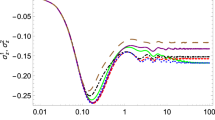Abstract
By solving the Fokker–Planck equations, the distribution functions of heavy particles in a thermostat of light particles (Rayleigh gas) with and without external sources of heavy particles were previously obtained. From the obtained non-stationary distribution functions, having determined the entropy according to L. Boltzmann, analytical expressions for the production of entropy in open and isolated systems are found. The first introduced the concept of production of negentropy. The algebraic sum of the entropy and negentropy productions is defined as the generalized entropy production. It is shown that the sign of the generalized production of entropy determines the direction of relaxation of the open system, and the equality of the generalized production of entropy to zero ensures the balance of entropy and the stationarity of the state of the system. The second law of thermodynamics in open systems is formulated as, when an open system relaxes into a nonequilibrium stationary state, the generalized production of entropy decreases in absolute value and is equal to zero in a stationary nonequilibrium state.
Similar content being viewed by others
Data availability
This article does not contain any additional data.
References
Kostic MM (2020) The second law and entropy misconceptions demystified. Entropy 22:648.
Struchtrup H (2020) Entropy and the second law of thermodynamics—the nonequilibrium perspective. Entropy 22:793.
Cocconi L, Garcia-Millan R, Zhen Z, Buturca B, Pruessner G (2020) Entropy production in exactly solvable systems. Entropy 22:1252.
Anderson K, Shuler KE (1964) On the relaxation of the hard sphers Rayleigh and Lorentz gas. J Chem Phys 40(3):633–650
Tadjibaev PA (1987) Implementation of the Glansdorf-Prigozhin evolution criterion for a Rayleigh gas with a chemical reaction and an external particle source. J Chem Phys 61(1):263–267 ((in Russian))
Tadjibaev PA, Tadjibaev DP (2016) Entropy production extrema and the second law in the Rayleigh gas. arXiv:1610.00499(in Russian)
Osipov AI, Tadjibaev PA (1989) Chemical physics of combustion and explosion processes. Kinetics of chemical reactions. In: Proceedings of the all-union symposium on combustion and explosion, Chernogolovka, pp 60–63 (in Russian)
Osipov AI (1999) Thermodynamics yesterday, today and tomorrow. Part 1. Equilibrium thermodynamics. Soros Educ J 4:79–85 ((in Russian))
Tadjibaev PA (2022) Extremal principles of thermodynamics for an exactly solvableRayleigh gasmodel. In: Bulletin Branch of NRNU “MEPhI” in Tashkent. Tashkent, 100214, Uzbekistan, vol 1, pp 72–78 (in Russian)
Acknowledgements
The authors express their gratitude for the fruitful discussions to Djanenkhodzhe Kalikulov, Research Assistant Professor at the Fralin Biomedical Research Institute at VTC.
Funding
We declare that the work was not supported by any foundations and was not financed by grants.
Author information
Authors and Affiliations
Contributions
Both authors jointly discussed, conceived and wrote the manuscript. Pulat Tajibaev has the right to act on behalf of all co-authors in the process of evaluation and publication of the manuscript.
Corresponding author
Ethics declarations
Competing interests
We declare we have no competing interests.
Additional information
Publisher's Note
Springer Nature remains neutral with regard to jurisdictional claims in published maps and institutional affiliations.
Rights and permissions
Springer Nature or its licensor (e.g. a society or other partner) holds exclusive rights to this article under a publishing agreement with the author(s) or other rightsholder(s); author self-archiving of the accepted manuscript version of this article is solely governed by the terms of such publishing agreement and applicable law.
About this article
Cite this article
Tadjibaev, P.A., Tojiboev, O.M. The second law of thermodynamics for open systems. J Eng Math 142, 9 (2023). https://doi.org/10.1007/s10665-023-10294-3
Received:
Accepted:
Published:
DOI: https://doi.org/10.1007/s10665-023-10294-3




